Lifestyle
Find Your Aesthetic: How to Decide on Home Decor Style!
Intrigued to discover your ideal home decor style? Explore design quizzes, sensory elements, and personalized recommendations to craft a space that truly resonates with you.

Discovering your ideal home decor style involves exploring your experiences and design preferences, engaging all your senses, and using data to guide your decisions. By diving into quizzes and understanding your personal style archetype, you can create a space that truly feels like home. Pay attention to materials, scents, and background noises to shape immersive experiences. Utilize audience profiling for targeted ads tailored to your demographics and interests. Take an interior design quiz to reveal your unique tastes and connect with designers specializing in your preferred style. Uncover how to transform your living space into a true reflection of your style.
Key Takeaways
- Consider personal experiences, culture, and family influences for style inspiration.
- Take an interior design quiz to uncover unique preferences.
- Engage all senses for a holistic design approach.
- Connect with designers specializing in your preferred style.
- Transform your living space into a reflection of your personal aesthetic.
Personal Style Discovery Tips
Consider your personal experiences, culture, and family influences when discovering your home decor style. Your style is a reflection of who you are, so understanding your personal preferences is crucial. Utilize home decor style quizzes or interior design style questionnaires to help pinpoint your unique design preferences. These tools can provide insights into your personal style archetype, guiding you in creating a space that truly feels like home. When considering your personal experiences, culture, and family influences, it’s important to also take into account any specific home decor styling tips you may have picked up along the way. Whether it’s a color scheme you love, a certain theme that has always resonated with you, or specific textures that appeal to your senses, these tips can help guide your decisions in creating a space that feels authentic and comfortable to you. By combining your personal style preferences with these home decor styling tips, you can create a home that truly reflects who you are.
Interior designers often recommend blending different design styles to achieve a cohesive and personalized look. Embrace the idea that your personal style may encompass elements from traditional, boho, farmhouse, French country, and modern styles. Mix and match these influences to create a unique and eclectic design aesthetic that speaks to your individuality.
Sensory Design Experience Insights

To enhance your home decor style and create a more immersive design experience, pay attention to the sensory elements within your space such as materials, scents, and background noise. Design goes beyond just what meets the eye; it encompasses a holistic sensory design approach that engages all your senses.
By focusing on textures that you can feel, scents that you can smell, and background noise that you can hear, you can shape experiences and create lasting memories within your space.
Crafting a sensory design experience involves considering how your space interacts with all your senses. By incorporating these sensory elements into your design style, you can elevate the ambiance of your home and make it more enriching.
Think about how different materials feel against your skin, the scents that evoke specific moods, and the background noise that sets the tone for your space. Engaging all your senses will help you achieve a more immersive and memorable design style.
Data-Driven Content Optimization Strategies

Enhance your content optimization strategies by leveraging data-driven approaches to personalize advertising and tailor content for specific audiences. When it comes to finding your design style and creating a unique look for your home, data-driven strategies can help you achieve the perfect aesthetic.
Here's how you can use data to optimize your content:
- Utilize an interior design quiz: Engage your audience with interactive quizzes to gather insights about their preferences.
- Personalize based on quiz results: Tailor your content recommendations and product suggestions according to the quiz responses.
- Optimize content relevance: Analyze user behavior and preferences to deliver customized content that resonates with your audience.
- Improve user experience: Enhance the overall user experience by providing relevant and personalized content that matches their unique style.
Audience Profiling for Advertising Benefits

When refining your home decor style, utilizing audience profiling for targeted advertising benefits can greatly elevate your strategy. By developing detailed profiles that tailor ads to specific demographics, interests, and behaviors, you can enhance ad effectiveness and engagement.
Analyzing audience profiles allows you to measure ad relevance and make adjustments to targeting strategies, ultimately improving ad ROI. Leveraging data insights from audience profiling enables you to optimize ad placements strategically, increasing conversion rates.
Personalized ads based on audience profiles can lead to more effective and efficient advertising campaigns. Understanding your audience through profiling not only helps in delivering the right message but also guarantees that your ads are seen by the most relevant individuals.
Interior Design Style Quiz Recommendations

Consider taking an interior design style quiz to uncover your unique design preferences and discover whether your style aligns with Bohemian, Glam, or Midcentury Modern aesthetics. This quiz can help you find the perfect aesthetic for your home decor by providing personalized results tailored to your tastes.
Here's why you should give it a try:
- Discover Your Unique Style: The quiz will explore your preferences and guide you towards a design style that resonates with your personality.
- Match with Specialized Designers: Use the quiz results to connect with designers who excel in the specific style that speaks to you.
- Create a Home Reflecting Your Aesthetic: With insights from the quiz, you can transform your living space into a true reflection of your unique style and taste.
- Seamless Design Process: Explore how past clients have praised the quiz for its smooth design process, resulting in high-quality outcomes that match their aesthetic vision.
Conclusion
Now that you've explored different tips and strategies for discovering your home decor style, you're well on your way to creating a space that truly reflects your personality and preferences. As you continue to refine your home decor style, don’t be afraid to mix and match different elements from various home decor styles to create a unique and personalized look. Whether you prefer the clean lines of modern minimalist design, the cozy feel of rustic farmhouse decor, or the bold colors and patterns of bohemian style, there are endless possibilities for creating a space that feels like home. Keep experimenting and have fun incorporating different home decor styles until you find the perfect blend that speaks to you.
Keep experimenting, exploring, and refining your aesthetic until you find the perfect balance that speaks to you.
Remember, the journey to finding your unique style is all part of the fun and excitement of making your house feel like a home.
Happy decorating!
Lifestyle
The Science of Perfect Bread Crust Formation
Not all bread crusts are created equal; discover the secrets behind achieving a perfect crust that will leave you craving more.
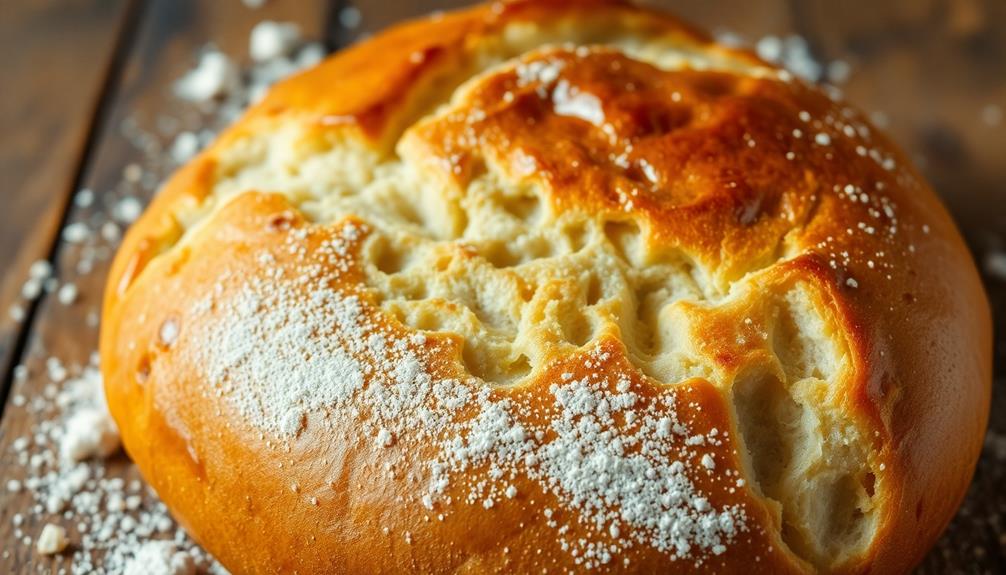
To achieve the perfect bread crust, you need to pay attention to ingredients, temperature, and technique. Start with bread flour for extra protein, enhancing gluten development. Verify your dough's hydration is between 60% and 75% for crispiness. Fermentation is key; it strengthens gluten and enhances flavor. High baking temperatures promote the Maillard reaction, giving your crust that rich color and taste. Steam during baking keeps the dough pliable, allowing for maximum oven spring. Each element plays a role in the final crust's texture and appeal. Curious about the intricate details behind these processes? There's much more to explore!
Key Takeaways
- Choosing bread flour enhances gluten development, resulting in a stronger dough structure and a better crust.
- Hydration levels between 60% to 75% create steam during baking, contributing to a crispier crust.
- The Maillard reaction occurs at high temperatures, producing complex flavors and a desirable brown color on the crust.
- Proper fermentation strengthens gluten structure and enhances flavor, preventing overproofing for optimal loaf rise.
- Preheating the oven and generating steam at the start of baking promote oven spring and improve crust quality.
Key Ingredients for Bread
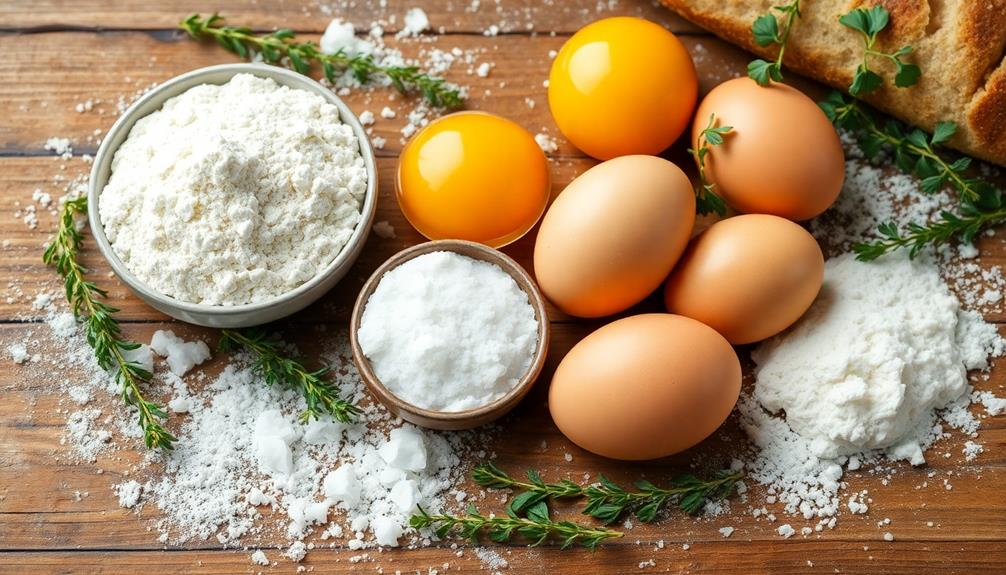
When it comes to baking perfect bread, five key ingredients play an indispensable role in achieving that ideal crust. First, consider the flour you choose. Opt for bread flour, as its higher protein content enhances gluten development, resulting in a chewier, well-structured crust.
Additionally, the use of high-quality ingredients is essential, much like how traditional Italian dishes, such as Agnolotti, rely on fresh, regional components to elevate their flavors.
Next, water is essential; the hydration level in your dough directly impacts crust formation. Increasing the water content generates steam during baking, giving you that desired crispiness.
While yeast is crucial for fermentation, let's focus on its interaction with sugar. Sugar not only feeds the yeast but also promotes the Maillard reaction and caramelization during baking. This means your crust will have enhanced flavor and a beautiful golden-brown finish.
Additionally, don't forget about salt; it regulates yeast activity and strengthens the gluten matrix, which is vital for a balanced loaf.
The Role of Yeast
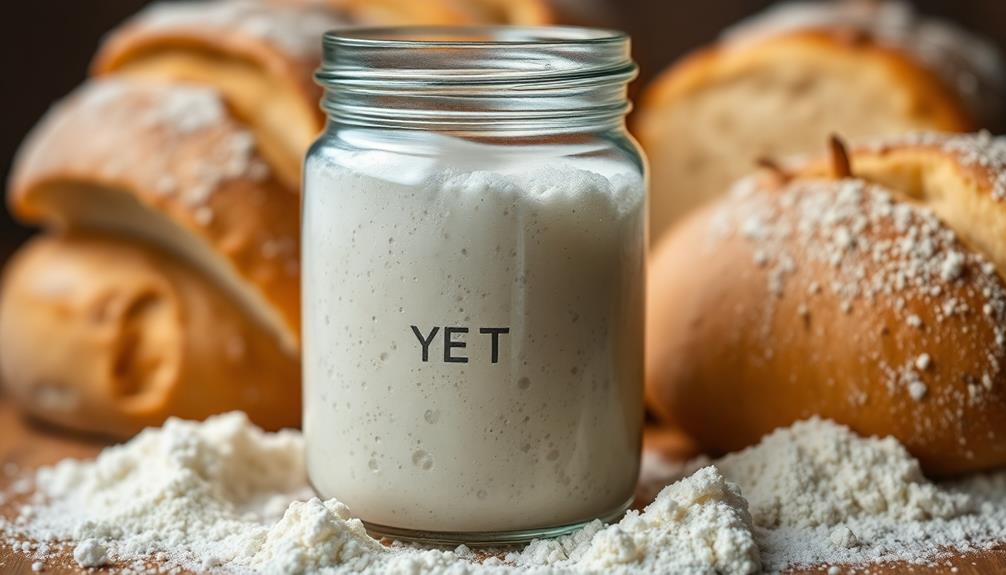
Yeast's role in bread baking is essential, acting as the natural leavener that transforms your dough. The primary yeast used is Saccharomyces cerevisiae, which ferments the sugars in your dough, producing carbon dioxide that causes it to rise.
This fermentation process not only increases the volume of your bread but also enhances its flavor and texture, particularly in the crust. In a similar way, the slow braising of pork belly in traditional Chinese dishes allows for rich flavor development, showcasing the significance of controlled cooking processes in achieving the desired results.
Here are four key aspects of yeast's role in bread-making:
- Activation: Active dry yeast needs to bloom in lukewarm water, while instant yeast hydrates quickly, speeding up fermentation.
- Carbon Dioxide Production: As yeast consumes glucose from starch breakdown, it releases carbon dioxide and ethanol, contributing to the bread's rise.
- Flavor Development: Longer fermentation times allow for more complex flavors to develop, which is vital for a delicious crust.
- Crust Browning: During baking, the Maillard reaction occurs, allowing for better crust color and flavor due to the fermentation process.
Understanding Gluten Formation
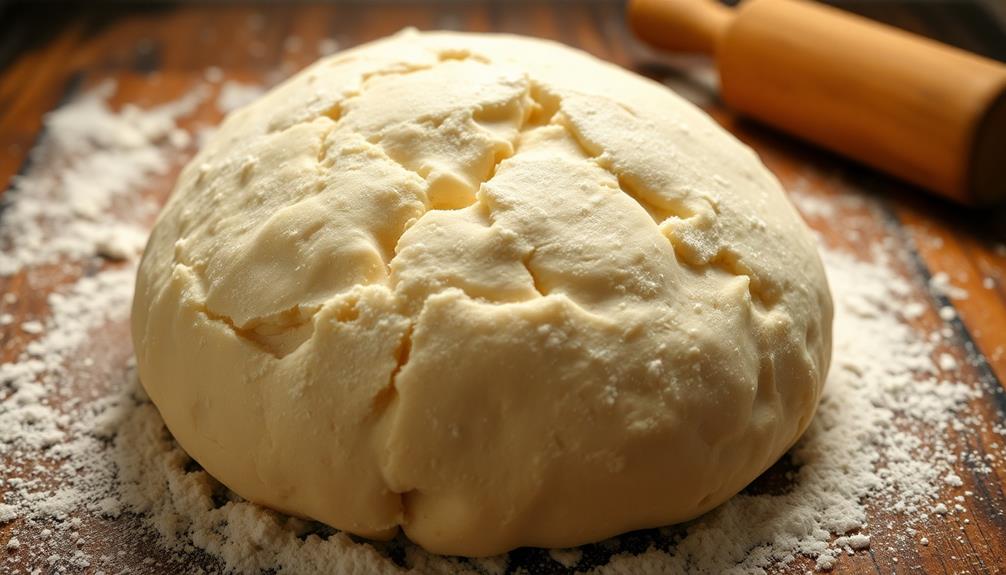
To make perfect bread, you need to understand gluten formation, as it's essential for your dough's elasticity and strength.
The principles of gluten development can also be seen in the preparation of traditional Brazilian dishes like Cuscuz Paulista, where the texture is influenced by the ingredients used.
When gliadin and glutenin proteins bond, they create a network that influences the crust's texture and overall structure.
Gluten Protein Interactions
Gluten formation consistently begins with the hydration of flour's proteins, glutenin and gliadin, which interact to create a robust network that gives your dough its structure and elasticity. This interaction is essential for achieving that perfect bread crust during baking, much like how the creamy texture of a Nettle and Potato Soup enhances its flavor profile.
To optimize gluten development, keep these points in mind:
- Hydration Levels: Aim for a hydration range of 60% to 75%. Higher hydration enhances extensibility and chewiness in your bread.
- Kneading Technique: Knead the dough to align gluten strands, which strengthens gluten and traps gases produced during fermentation.
- Fermentation Process: Allow the gluten matrix to develop further during fermentation and proofing, as this helps the dough expand and contributes to an open crumb structure.
- Avoid Over-Kneading: Be mindful not to over-knead; excessive gluten development can make the dough too rigid, preventing proper gas expansion and leading to a tough texture.
Dough Elasticity and Strength
Understanding dough elasticity and strength is vital for any baker aiming to create the perfect loaf. When you mix water with bread flour, you activate proteins glutenin and gliadin, which form a gluten matrix. This network provides your dough with the elasticity and strength required for a successful rise.
Just as the rich blend of spices in a Mushroom Masala enhances its flavor, the proper balance of ingredients in your dough will elevate the final bread's taste and texture.
The way you mix your dough matters. Higher mixing speeds can enhance gluten formation, creating a stronger dough that holds onto gas bubbles better. This gas retention is significant for achieving an impressive dough rise during fermentation and baking.
Using bread flour, which contains around 12-14% protein, gives you a stronger gluten network compared to all-purpose flour. This higher protein content results in a chewier texture and improved structure in your final bread.
As the dough ferments, the gluten matrix continues to strengthen, allowing for an open crumb structure. Proper gluten development guarantees your dough is stretchy and voluminous, directly affecting the quality and texture of your bread.
Impact on Crust Texture
The texture of your bread's crust largely hinges on the effectiveness of gluten formation during the mixing and fermentation processes. When you hydrate the gluten-forming proteins, glutenin and gliadin, in flour, they create a strong elastic network that's essential for your dough's structure and gas retention. This is crucial for achieving that desirable crust and crumb.
Just like the rich, satisfying crust of a Loaded Baked Potato enhances its overall appeal, the right gluten development can elevate your bread-making to new heights.
Here are four key factors that impact the crust texture:
- Protein Content: Higher protein flours, like bread flour, yield a chewier, more resilient crust.
- Kneading Technique: Proper mixing and kneading align gluten strands, enhancing dough elasticity and strength.
- Fermentation Duration: Allowing your dough to ferment adequately retains carbon dioxide, leading to an open crumb structure.
- Oven Spring: During the baking process, the expansion of gas bubbles contributes considerably to your bread's crust texture and volume.
As the dough bakes, the proteins coagulate within the gluten network, forming a sturdy crust.
Understanding these elements helps you master the art of bread-making, ensuring a satisfying texture every time.
Dough Transformations Explained
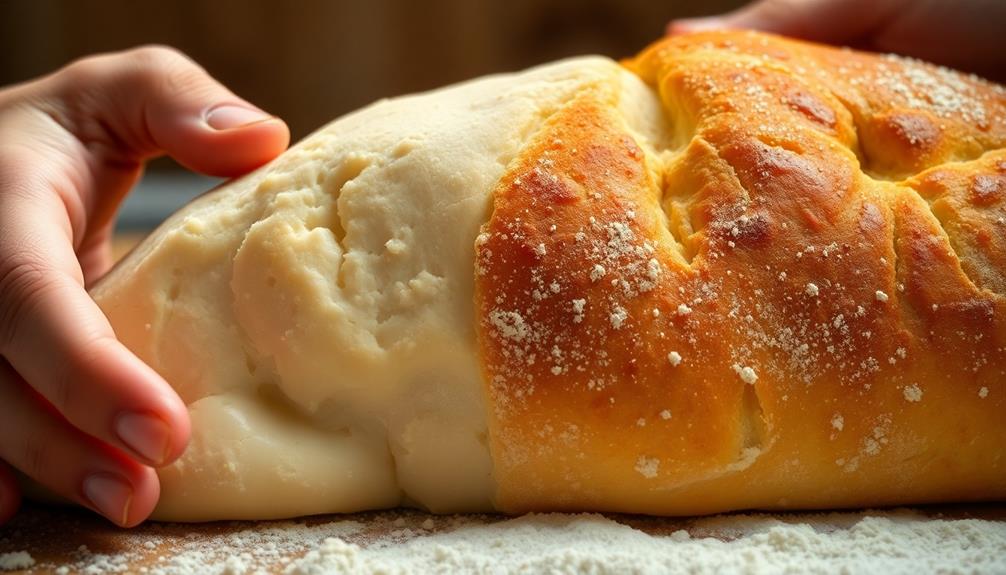
When you mix water with flour, the hydration kicks off essential transformations in your dough. This process can be likened to the culinary traditions from around the world, where the right combination of ingredients leads to unique and flavorful dishes.
As yeast gets to work, it consumes sugars and produces carbon dioxide, making your dough rise and enhancing its flavor.
Temperature plays a key role too, impacting the texture and final crust you achieve when baking.
Dough Hydration Effects
Hydration levels in your dough play an important role in its transformation during baking. The right amount of water content in dough not only affects its structure but also influences the final crust texture.
For instance, just as the balance of ingredients is essential in dishes like Muamba De Galinha that rely on specific flavors and textures, dough hydration needs to be carefully managed.
Here are four key points to think about regarding dough hydration:
- Extensibility: Higher dough hydration (70% or more) improves extensibility, allowing better gas retention and creating a more open crumb structure.
- Gluten Formation: Increased water activates glutenin and gliadin proteins, enhancing dough strength and elasticity, critical for good bread.
- Enzymatic Breakdown: As dough hydrates, enzymes like amylase become active, breaking down starches into fermentable sugars, enriching flavor and crust color during baking.
- Crust Texture: The right hydration balance is essential; overly hydrated dough can yield a soft crust, while ideal hydration promotes a crisp, well-caramelized crust due to effective steam generation.
Yeast Activity Dynamics
Understanding yeast activity is fundamental for mastering bread-making, as it directly influences dough transformations. Yeast respiration kicks off when you hydrate the yeast, especially with active dry varieties that need to bloom in lukewarm water. Instant yeast hydrates quicker, making it easier to incorporate into your dough. This process is somewhat akin to preparing for a Thanksgiving feast where turkey soup and other dishes rely on rich flavors developed through careful preparation.
During fermentation, yeast consumes glucose generated from starch breakdown, releasing carbon dioxide and ethanol. This process is essential as it's what causes the dough to rise and develop complex flavors. As the dough undergoes bulk fermentation, it can double in size, and the duration of this stage is critical.
Longer bulk fermentation not only enhances flavor but also strengthens the gluten structure.
Once you move to the final proofing stage, the dough replenishes carbon dioxide and ethanol, preparing it for baking. The timing and temperature adjustments here can greatly affect how well your dough rises and the final texture of your bread.
When you place the dough in the oven, it experiences oven spring—an explosion of gas expansion that leads to a rise until the dough structure can no longer hold the pressure. Master these dynamics to achieve that perfect crust!
Temperature and Texture
Temperature plays an essential role in transforming dough during the baking process, directly affecting the crust's texture and overall quality. As you bake, understanding these key temperature-related transformations can help you achieve the perfect crust:
- Starch Gelatinization: Occurs between 91°C and 93°C (195°F and 200°F), where starch granules burst, forming a gel network that contributes to the crumb structure. This transformation is similar to the way marinades enhance the texture of marinated dishes like bulgogi by breaking down proteins and allowing flavors to seep in.
- Moisture Evaporation: The outer surface quickly reaches 100°C (212°F), essential for initiating crust development as moisture evaporates.
- Maillard Reaction: Begins at temperatures over 130°C (265°F), enhancing both flavor and color of the crust.
- Balance of Heat and Moisture: A higher hydration level generates more steam, resulting in a crisper crust.
The interplay of these factors is significant. A well-controlled temperature guarantees that the crust not only browns beautifully but also retains the right amount of moisture, preventing it from becoming too dry or chewy.
Embracing these temperature principles will elevate your bread-baking game, leading to a crust that's both flavorful and texturally superior.
Importance of Bulk Fermentation
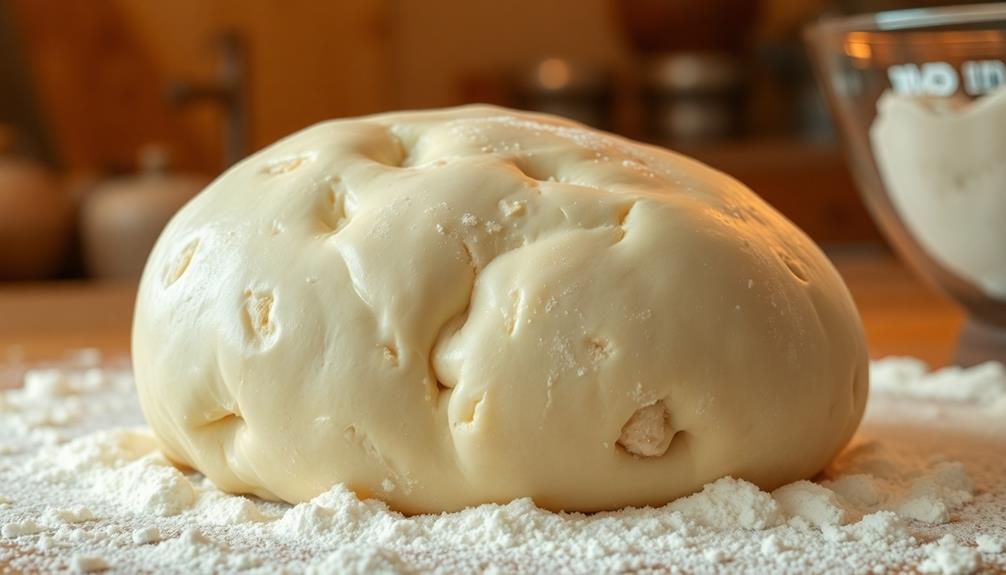
During the initial stages of bread making, bulk fermentation plays an essential role in the dough's development. This phase is where the dough typically doubles in size, allowing yeast to consume sugars and produce carbon dioxide. This gas is fundamental for leavening, helping your bread rise beautifully.
As the dough ferments, it also enhances flavor through complex biochemical reactions, resulting in a more nuanced taste profile in your final bread.
During bulk fermentation, the gluten structure strengthens, which contributes to the dough's elasticity and its ability to retain gas. This is critical for achieving that open crumb texture everyone loves.
The duration of this fermentation can vary, usually lasting from 1 to 2 hours at room temperature, or longer if you opt for retarded fermentation in the fridge, which can further improve flavor and texture.
Managing bulk fermentation properly is key. It helps prevent overproofing, which could lead to a collapsed loaf or undesirable off-flavors from excessive yeast activity.
Baking Process Overview
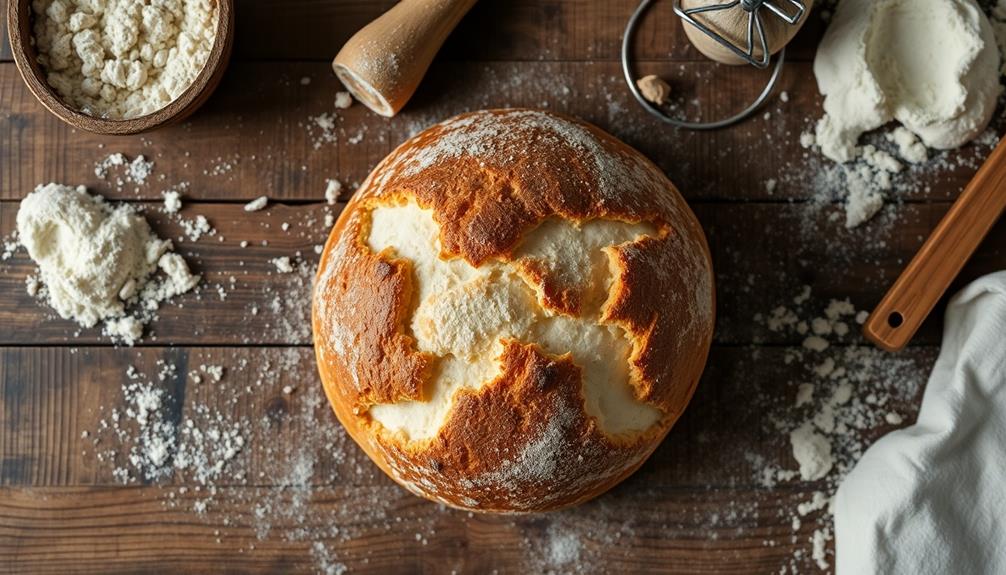
Baking is the transformative stage where your carefully crafted dough becomes a delicious loaf of bread. The baking process begins by preheating your oven to a high temperature, usually around 500°F (260°C). This initial heat promotes oven spring and enhances the crust's caramelization.
As the dough heats, steam generated within helps keep the surface pliable, allowing for maximum expansion before the crust sets.
Here are four key elements for successful baking:
- Oven Temperature: Start with a high temperature to activate the Maillard reactions, which create complex flavors and a rich brown crust.
- Steam: Maintain steam in the oven during the first phase to prevent the crust from hardening too quickly.
- Timing: Monitor your baking time carefully; underbaking can lead to a gummy texture, while overbaking can burn the bottom.
- Venting: After the initial phase, venting steam is essential to achieving a well-defined crust without affecting the loaf's bottom.
Crust Formation Mechanisms
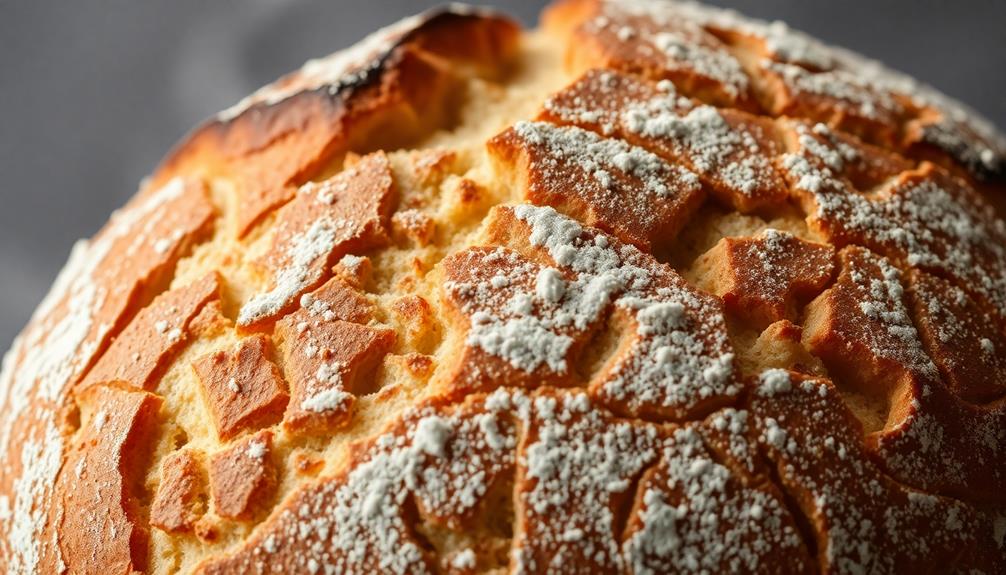
When you bake bread, temperature plays an essential role in determining the texture of the crust.
You'll notice that the Maillard reaction kicks in at higher temperatures, adding those delightful flavors and colors.
Additionally, managing moisture loss effectively can make or break the quality of your crust, influencing its final appearance and crunch.
Temperature and Texture Impact
The interplay of temperature and texture is fundamental for achieving the perfect bread crust. When you bake bread, the temperature of the dough plays a significant role in crust formation. As the heat rises above 130°C (265°F), gelatinised starch begins to swell and create a cohesive network that holds the bread structure together.
Here are four key factors to examine:
- Baking Temperature: Ideal baking occurs between 91°C and 93°C (195°F and 200°F) for proper starch gelatinization.
- Steam Introduced: Adding steam during baking enhances heat transfer, allowing the crust to develop better and thicker.
- Oven Spring: The right temperature promotes oven spring, contributing to a lighter texture and improved crust.
- Cooling: Proper cooling post-baking is essential. It prevents a gummy texture by redistributing moisture within the crumb.
Maillard Reaction Significance
Understanding the importance of the Maillard reaction is essential to mastering bread crust formation. This chemical reaction occurs between amino acids and reducing sugars at high temperatures, typically above 140°C (284°F). It's responsible for producing complex flavors and the appealing brown color of your bread's crust.
During the initial stages of baking, maintaining moisture is vital. It creates an ideal environment for the Maillard reaction, enhancing flavor development and allowing heat to transfer effectively. A well-executed Maillard reaction results in a crust that's not just visually enticing with its deep golden hue, but also rich in aroma and taste.
It's important to strike a balance between caramelization and the Maillard reaction. Higher baking temperatures favor the latter, leading to a richer flavor complexity that elevates your bread.
Moisture Loss Effects
Moisture loss plays a crucial role in shaping the bread crust during baking. As the temperature rises, water vaporizes, leading to the formation of a dry, hard, and dense crust that enhances both flavor and texture. This process greatly influences the final crust quality, making it essential for bakers to understand moisture dynamics.
Here are four key effects of moisture loss on crust formation:
- Crust Texture: A well-formed crust provides a satisfying crunch, while excessive moisture loss can lead to an undesirable, too-dry texture.
- Flavor Development: Proper moisture loss during baking allows complex flavors to develop, enhancing the overall taste of the bread.
- Cooling Effects: As bread cools, moisture migrates, leading to staling that can alter the crumb's texture if not managed correctly.
- Economic Value: High-quality crusts can improve a bread's marketability, making moisture control crucial for bakers.
Temperature and Texture Effects
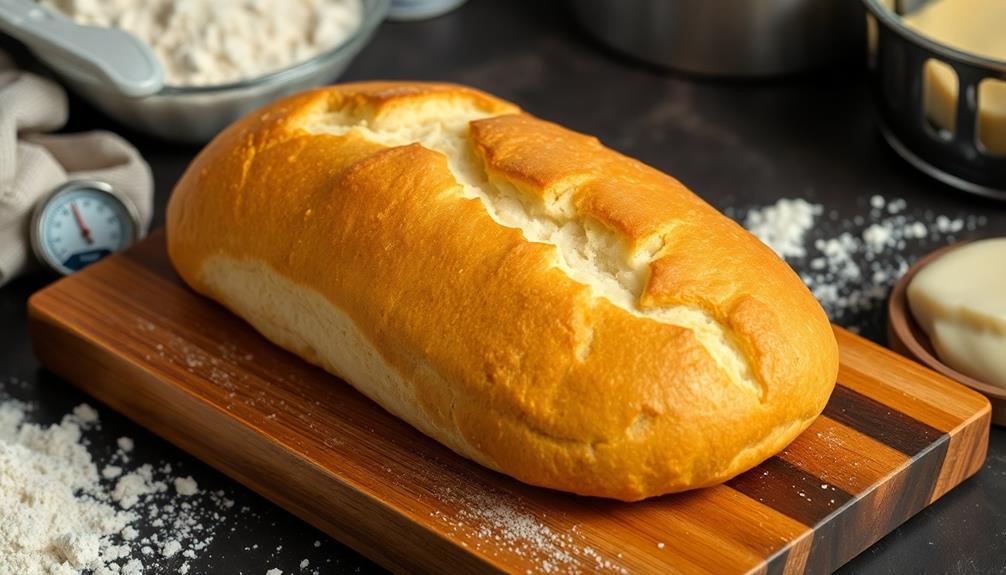
Achieving the perfect bread crust relies heavily on temperature, which plays an essential role in determining both flavor and texture. When you bake bread, the crust formation kicks off at temperatures above 130°C (265°F). This is where the Maillard reaction and caramelization come into play, enhancing the flavor and deepening the color of your crust.
During baking, starch gelatinization occurs between 91°C and 93°C (195°F to 200°F). As starch granules burst and form a gel, they markedly contribute to the crust's texture. Starting with a high baking temperature is imperative; it promotes oven spring, allowing gases to expand quickly for a thick, desirable crust.
However, don't overlook moisture. The moisture content in the crust directly affects its texture. A dry crust means efficient moisture loss, while too much moisture can lead to a soggy texture.
Homemade vs. Store-Bought Bread
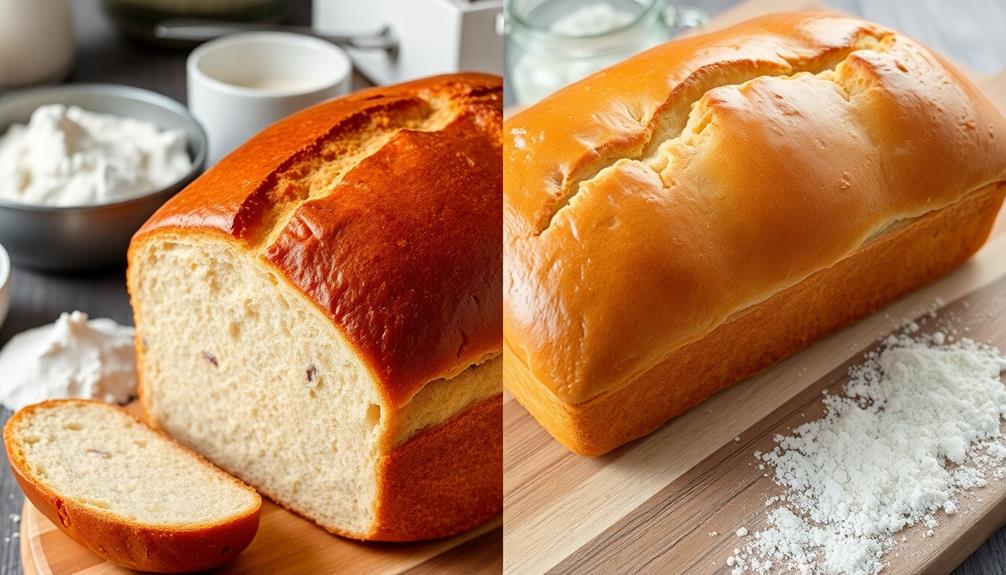
When it comes to bread, homemade options often shine in comparison to store-bought varieties. You can control every aspect of the bread baking process, leading to superior crust formation and taste.
Here are four key advantages of homemade bread:
- Enhanced Crust: You can adjust baking conditions like temperature and steam, resulting in a thicker, crunchier crust that store-bought bread often lacks.
- Complex Flavor: The Maillard reaction is more pronounced in your homemade bread. You get to experiment with different techniques and temperatures to achieve rich flavors and appealing colors.
- Quality Ingredients: Unlike store-bought bread, which may contain preservatives, you can opt for fresh, natural ingredients that contribute to a more satisfying eating experience.
- Longer Fermentation: Homemade bread allows for longer fermentation times, which not only improves flavor development but also creates a texture that mass-produced bread simply can't match.
Supporting Real Bread Initiatives
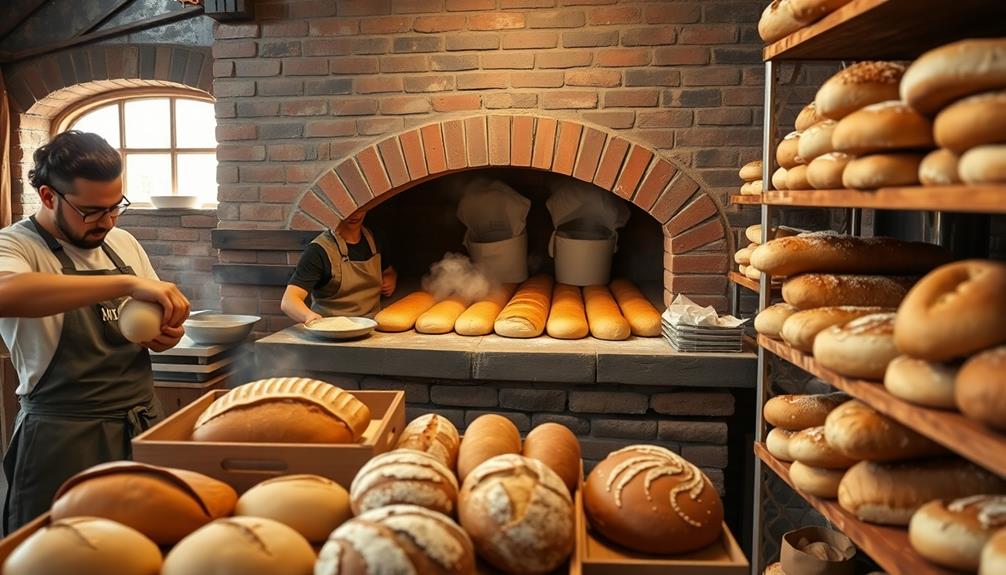
Supporting real bread initiatives not only enhances your baking skills but also promotes a healthier food culture. By joining the Real Bread Campaign, you align yourself with a movement that values quality and sustainability. This charity focuses on traditionally made bread, encouraging home bakers like you to embrace simple ingredients and better practices.
Your contributions help fund educational programs that teach the science behind real bread-making. You'll gain access to a wealth of resources, including recipes and news, fostering a community of informed bakers. This knowledge empowers you to create bread that's not only delicious but also made with integrity.
Moreover, the campaign emphasizes honest labeling practices, helping you make informed choices about the bread you purchase. Supporting local food initiatives means you're also contributing to your community's health and economy.
Frequently Asked Questions
How Do You Get the Perfect Crust on Bread?
To get the perfect crust on bread, start with high hydration dough, preheat your baking surface, introduce steam during the first 15 minutes, score the dough, and watch for a golden color and hollow sound.
How Is the Crust of Bread Formed?
The crust of bread forms through heat, moisture evaporation, and chemical reactions. When you bake, the high temperature creates a crispy texture, while steam helps with expansion. Scoring the dough guarantees an even, beautiful crust.
What Is the Science Behind Bread Making?
Bread making's like an art; each ingredient plays its part. You mix flour, water, and yeast, letting them dance through fermentation. Heat transforms them into a delicious loaf, creating flavors and textures you'll love.
What Is the Science Behind Proving Dough?
When you prove dough, yeast ferments sugars, creating carbon dioxide that helps it rise. You'll notice it doubling in size, and a gentle press should show it springs back slowly, indicating it's ready for baking.
Conclusion
As you pull a loaf from the oven, the golden crust crackles like a warm embrace, releasing an aroma that dances through your kitchen. You've harnessed the science behind perfect bread, transforming simple ingredients into a masterpiece. Each bite reveals a symphony of textures, from the crisp exterior to the soft, airy interior. With every loaf you bake, you're not just making bread; you're crafting warmth, comfort, and the joy of sharing with loved ones.
Lifestyle
How Sleep Quality Affects Dietary Choices
Keen insights reveal how sleep quality directly influences your cravings and dietary choices, but what happens when those choices spiral out of control?

Your sleep quality greatly affects your dietary choices, influencing your cravings and what you ultimately consume. When you're sleep-deprived, you tend to crave high-fat and sugary snacks, leading to impulsive eating and poor nutrition. A lack of sleep correlates with higher caloric intake and a preference for energy-dense foods, which can exacerbate weight gain. On the flip side, a balanced diet rich in fiber, fruits, and whole grains can enhance sleep quality. Recognizing the connection between sleep and eating habits can empower you to make healthier choices. There's more to explore about how these factors interact.
Key Takeaways
- Poor sleep leads to increased cravings for high-fat and sugary snacks, promoting unhealthy eating habits.
- A balanced diet, rich in fruits and whole grains, can enhance sleep quality and reduce cravings.
- Consistent meal times support circadian rhythms, improving overall sleep and dietary choices.
- Foods high in tryptophan and magnesium promote sleep by boosting serotonin and relaxation.
- Lack of sleep correlates with higher caloric intake and a preference for energy-dense, unhealthy foods.
The Connection Between Sleep and Diet

When you think about your nightly rest, consider how it influences your food choices the next day. Sleep quality plays a significant role in shaping your dietary patterns. If you experience poor sleep, you might find yourself reaching for snacks high in saturated fat or sugary foods, leading to increased caloric intake.
For instance, the temptation for quick energy sources may lead you to indulge in treats like Brigadeiro or other high-calorie options. Studies show that short sleepers often consume fewer types of foods but end up with higher energy intakes, which can result in poor nutrition.
On the flip side, a diet rich in fruits, vegetables, and whole grains can improve your sleep quality. The Mediterranean diet is a prime example, emphasizing healthy fats, lean proteins, and a variety of whole grains. This dietary approach has been linked to fewer insomnia symptoms and better restorative sleep.
If you struggle with sleep, it might be worth examining your food choices. Incorporating more fiber-rich foods could help you sleep better, breaking the cycle of poor sleep and unhealthy eating.
Ultimately, prioritizing a balanced diet not only enhances your daily energy levels but also improves your overall sleep quality, creating a positive feedback loop for both your sleep and nutrition.
How Sleep Affects Food Cravings

Sleep greatly influences your food cravings, often steering you toward unhealthy choices. When you experience poor sleep quality, your body struggles with hormonal balance, increasing ghrelin (the hunger hormone) while decreasing leptin (the satiety hormone). This imbalance leads to stronger cravings for high-calorie, sugar-laden foods.
| Factor | Impact on Food Choices |
|---|---|
| Sleep Deprivation | Increases cravings for carbs |
| Poor Sleep Quality | Promotes impulsive eating |
| Hormonal Imbalance | Heightens desire for unhealthy foods |
| Higher Caloric Intake | Linked to weight gain |
Research shows that people with sleep disturbances often consume more snacks, particularly those rich in fat and sugar. You may find that decision-making and self-control diminish, making it harder to resist those tempting treats. Ultimately, chronic poor sleep quality fosters a cycle of unhealthy dietary choices, leading to increased caloric intake and potential weight gain. Recognizing this link between sleep and food cravings can empower you to make healthier choices and seek better sleep.
Foods That Enhance Sleep Quality

To improve your sleep quality, consider incorporating nutrient-rich foods into your diet. Eating the right meals at the right times can greatly impact your ability to fall asleep and stay asleep.
For instance, certain dishes like Nettle and Potato Soup are rich in vitamins and can provide a comforting, warm meal before bedtime.
Let's explore some key foods that can help you achieve a more restful night.
Nutrient-Rich Sleep Foods
Eating the right foods can greatly enhance your sleep quality, allowing you to wake up feeling refreshed. Incorporating nutrient-rich foods into your diet can greatly impact your sleep patterns. For instance, foods high in tryptophan—like turkey and dairy—promote the production of serotonin and melatonin, crucial for regulating sleep cycles.
Additionally, enjoying traditional dishes such as Muamba De Galinha, which is rich in flavor and often made with ingredients that support overall health, can be beneficial. Complex carbohydrates, such as oatmeal and whole-grain bread, can also improve your sleep by boosting insulin levels, which helps transport tryptophan to your brain more effectively.
Fatty fish, rich in omega-3 fatty acids and vitamin D, have been linked to better sleep quality due to their anti-inflammatory properties and their role in serotonin production.
Don't overlook tart cherry juice, a natural source of melatonin, which studies show can enhance sleep duration and quality when consumed before bedtime. Additionally, incorporating magnesium-rich foods like almonds and spinach into your nutrition can support relaxation and help regulate neurotransmitters that signal sleep.
Timing and Meal Impact
A well-timed meal can greatly enhance your sleep quality, just as the right foods can. Establishing consistent meal times plays an essential role in aligning with your body's circadian rhythms. Eating complex carbohydrates, like oatmeal or whole-wheat toast, about four hours before bedtime can facilitate serotonin and melatonin production, helping you drift off more easily.
Additionally, incorporating foods with umami flavors, such as ankimo (monkfish liver pâté), can provide a luxurious addition to your evening meals, promoting relaxation.
Consider incorporating these foods into your evening routine for better sleep:
- Fresh fruits and vegetables: Packed with fiber, they regulate hormones that affect sleep cycles.
- Low-fat proteins: Foods like fish and legumes support overall health and melatonin regulation.
- Whole grains: They provide lasting energy while promoting restful sleep.
Avoiding large meals or sugary snacks close to bedtime can prevent discomfort and sleep disruptions. Instead, focus on a balanced diet rich in fiber and carbohydrates throughout the day.
Foods That Disrupt Sleep Patterns
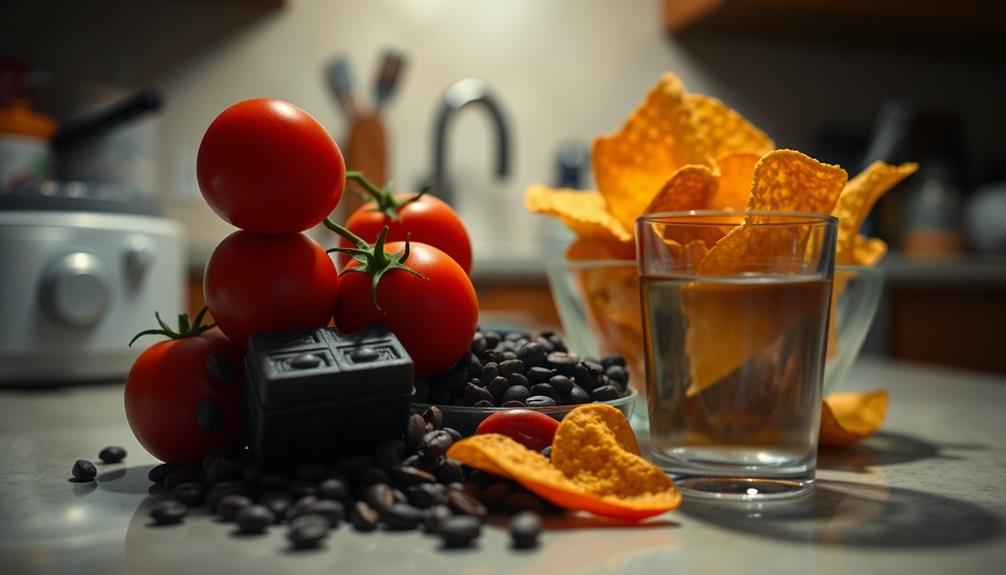
Disruption of sleep patterns can often be traced back to the foods you choose. For instance, consuming high-saturated fat foods like burgers and fries can reduce your restorative slow-wave sleep, ultimately hurting your sleep quality.
If you often find yourself waking up hungry at night, refined carbohydrates such as white bread and pasta might be the culprit, causing those annoying hunger awakenings that disrupt your sleep patterns.
Additionally, indulging in festive treats like Graveyard Taco Dip during celebrations can lead to discomfort due to their heavy ingredients.
Caffeine is another major disruptor; even when you have it six hours before bedtime, it can greatly hinder your ability to fall asleep, leading to a poorer overall sleep experience.
Alcohol consumption might seem relaxing initially, but it disrupts REM sleep and can lead to increased awakenings later in the night as its sedative effects wear off.
Lastly, eating large meals close to bedtime can cause discomfort and indigestion, making it tough for you to both fall and stay asleep.
Dietary Strategies for Better Sleep

Improving your sleep quality can be as simple as adjusting your dietary choices. By focusing on what you eat, you can create a healthier diet that promotes quality sleep. Here are some strategies to contemplate:
- Enjoy a bowl of oatmeal or whole-grain toast four hours before bedtime to boost serotonin and melatonin production. Additionally, incorporating foods rich in magnesium, such as spinach or nuts, can help relax your muscles and promote restful sleep.
- You might also contemplate a warm bowl of Mushroom Masala for its earthy flavors and comforting qualities, perfect for dinner.
- Incorporate tryptophan-rich foods like turkey and dairy, which can enhance your sleep quality.
- Fill your plate with fiber-rich fruits, vegetables, and whole grains for better digestion and fewer nighttime awakenings.
To further improve your sleep, keep consistent meal times. This helps regulate your circadian rhythms, allowing your body to know when it's time to wind down.
Also, avoid large meals and high-fat foods close to bedtime, as they can lead to discomfort and disrupt your sleep patterns.
The Role of Sleep in Nutrition Choices

Your sleep duration and quality play a vital role in the food choices you make. When you don't get enough rest, you might find yourself reaching for high-calorie snacks and missing out on a balanced variety of nutrients.
For example, a lack of sleep can lead to cravings for sugary treats, which could overshadow healthier options like Candy Corn Fruit Parfaits.
Understanding this connection can help you improve both your sleep and nutrition habits.
Sleep Duration Influence
Sleep duration plays an essential role in shaping dietary choices, as research reveals a clear connection between how much rest you get and what you eat. If you're getting less than 7 hours of sleep, you might notice some concerning patterns in your eating habits. Short sleepers often struggle with increased energy intake, particularly from unhealthy fats and snacks. This can lead to cravings for quick, high-calorie foods and even traditional dishes that are rich in flavor but may not always be the healthiest options, such as Tella and Tej.
Consider these factors:
- Higher fat intake: You may find yourself reaching for greasy foods, leading to poor nutrition.
- Reduced variety of food choices: Lack of sleep can limit your interest in diverse, nutrient-dense options.
- Increased daytime sleepiness: Poor sleep might make you crave quick, energy-dense foods for a boost.
The impact of poor sleep doesn't just stop at cravings; it can also result in lower macronutrient intakes, affecting your overall nutrition quality.
Insomnia symptoms may drive you to unhealthy dietary choices, making it even more important to prioritize healthy sleep. By aiming for adequate sleep duration, you can greatly improve your dietary choices and lead a healthier lifestyle.
Sleep Quality and Snacking
Quality sleep greatly influences snacking habits, shaping what and how much you consume throughout the day. When you experience poor sleep quality or short sleep duration, you're more likely to reach for high-calorie snacks, particularly those rich in fats and sugars.
For instance, indulging in dishes like Red-Braised Pork Belly can be tempting when sleep-deprived, as cravings for rich and savory foods often increase. Research shows that individuals who sleep less than seven hours a night often crave unhealthy snacks, leading to increased caloric intake and potential weight gain.
This tendency is linked to hormonal regulation; sleep deprivation disrupts the balance of hunger and satiety hormones. With higher levels of ghrelin, the hunger hormone, and lower levels of leptin, the satiety hormone, your appetite can go into overdrive.
As a result, you may find yourself snacking more frequently, especially on energy-dense options. Moreover, studies indicate that fat intake rises considerably during periods of sleep restriction.
As you struggle to get adequate rest, you mightn't only consume more snacks but also make poorer dietary choices, which can exacerbate metabolic issues over time. Prioritizing quality sleep can help you make healthier snacking decisions and maintain better overall nutrition.
Macronutrient Selection Patterns
When evaluating how macronutrient selection patterns influence nutrition choices, it's clear that inadequate sleep can lead to poor dietary decisions. If you're not getting enough rest, you might find yourself gravitating toward energy-dense foods, resulting in a skewed macronutrient selection.
This can manifest in your food choices as:
- High-fat snacks that satisfy cravings quickly, but leave you feeling sluggish.
- High-sugar treats that provide a temporary energy boost, followed by a crash.
- A stark neglect of healthy options, like those found in a Mediterranean diet, which can enhance sleep quality.
Additionally, incorporating traditional Indonesian dishes such as Kue Putu, made with rice flour and coconut, can offer a nutritious balance while satisfying sweet cravings.
Research shows that short sleepers often consume more calories, particularly from unhealthy fats and sugars. These dietary patterns can exacerbate sleep issues, creating a vicious cycle.
Notably, maintaining a healthy balance of macronutrients, like incorporating adequate carbohydrates, can improve sleep quality. Conversely, a high-protein diet can disrupt your sleep maintenance.
Frequently Asked Questions
How Does Sleep Affect Food Choice?
When you don't get enough sleep, your cravings for high-fat and sugary snacks often increase. You might find yourself reaching for unhealthy foods, leading to poor dietary choices that can affect your overall health.
How Does Diet Affect Sleep Quality?
Your diet considerably impacts your sleep quality. Eating heavy meals late, consuming caffeine or alcohol, and indulging in sugary foods can disrupt your sleep patterns, leading to poorer rest and increased awakenings during the night.
Why Is Sleep so Important for Nutrition?
Imagine a car running on empty; it sputters and stalls. Just like your body needs fuel, sleep's essential for nutrition. It helps you absorb nutrients, regulates hunger hormones, and keeps your energy steady throughout the day.
Does Sleep Quality Affect Appetite?
Yes, sleep quality definitely affects your appetite. When you're not sleeping well, you may find yourself craving unhealthy foods and eating more overall, as your body struggles to regulate hunger and fullness hormones effectively.
Conclusion
So, if you think you can survive on caffeine and late-night snacks while dreaming of kale, think again! Your sleep and diet are in a dramatic tango, where poor sleep leads to junk food cravings, and junk food leads to even worse sleep. It's a vicious cycle, like trying to outrun your own shadow. Embrace the power of quality sleep and balanced meals, and let your cravings do a happy dance instead of a chaotic cha-cha!
Lifestyle
The Unexpected Ways Urban Farming Is Changing Cuisine
Knowing how urban farming influences cuisine reveals surprising connections to flavor, sustainability, and community—discover the transformative impact it has on our plates.

Urban farming's transforming cuisine in surprising ways. You'll find chefs crafting menus based on ultra-fresh, local ingredients. With community-supported agriculture (CSA), you gain access to customizable baskets filled with seasonal produce. This close connection to food enhances flavors and encourages traditional dishes. As you cook with community-grown ingredients, you support local farmers and sustainability. Innovative techniques, like hydroponics, boost productivity and water efficiency, making urban farms essential to food security. Plus, educational workshops deepen your culinary skills. Keep exploring these trends, and you'll discover even more about how urban farming reshapes our plates and communities.
Key Takeaways
- Urban farming initiatives provide chefs access to ultra-fresh, hyper-local ingredients, enhancing menu creativity and sustainability.
- Community-supported agriculture (CSA) allows chefs to adapt dishes based on seasonal crop availability, promoting culinary innovation.
- Hands-on cooking workshops using local produce foster community engagement and deepen understanding of sustainable practices.
- Local dishes featuring nutrient-rich ingredients, like Nettle and Potato Soup, celebrate cultural significance and rich flavors.
- Technology-driven urban farms optimize resource use, producing high yields while minimizing water consumption, reshaping culinary sourcing.
Rise of Local Ingredients

As urban farming initiatives flourish, you'll find that local ingredients are becoming more accessible than ever. With programs like community-supported agriculture (CSA), around 25,000 customizable baskets of fresh produce are distributed weekly from urban farms, making it easier for you to enjoy locally sourced foods.
This surge in urban farming not only enhances food access but also greatly boosts food security in your community. For instance, dishes like Nettle and Potato Soup utilize fresh, local ingredients that are rich in nutrients.
The global vertical farming industry, projected to grow over 25% by 2027, plays an important role in this transformation. Farms such as GoodLeaf's vertical operations yield crops equivalent to traditional farming methods while using 95% less water, ensuring you have access to fresh ingredients year-round.
The pandemic has further fueled interest in local food sources, leading to demand spikes that are three to four times higher in many urban areas.
Culinary Innovation Through Sustainability

Urban farming is sparking a culinary revolution, giving chefs access to ultra-fresh, hyper-local ingredients that inspire creativity in the kitchen. By collaborating with urban farms, chefs can create dishes that celebrate the vibrant flavors of local food and seasonal produce.
The rise of community-supported agriculture (CSA) programs allows you to tailor your menu based on the crops available each week, fostering culinary innovation and adaptability. This movement mirrors the diversity found in Brazilian Cuisine, where local ingredients and cultural influences create a rich tapestry of flavors.
With vertical farms yielding as much as traditional farms while using 95% less water, sustainable food practices are becoming integral to your culinary approach. Initiatives like Lufa Farms' customizable CSA baskets enable you to source ingredients that highlight the freshness and quality of locally-grown produce, leading to unique and bespoke culinary creations.
As urban farms prioritize biodiversity and organic methods, you're inspired to experiment with heirloom varieties and lesser-known vegetables. This not only enriches local cuisine but also enhances the dining experience, offering your guests diverse flavors that reflect a commitment to environmental responsibility.
Embracing these sustainable practices, you're not just cooking; you're crafting a culinary narrative that celebrates the intersection of innovation and sustainability in modern cuisine.
Community Engagement in Cooking
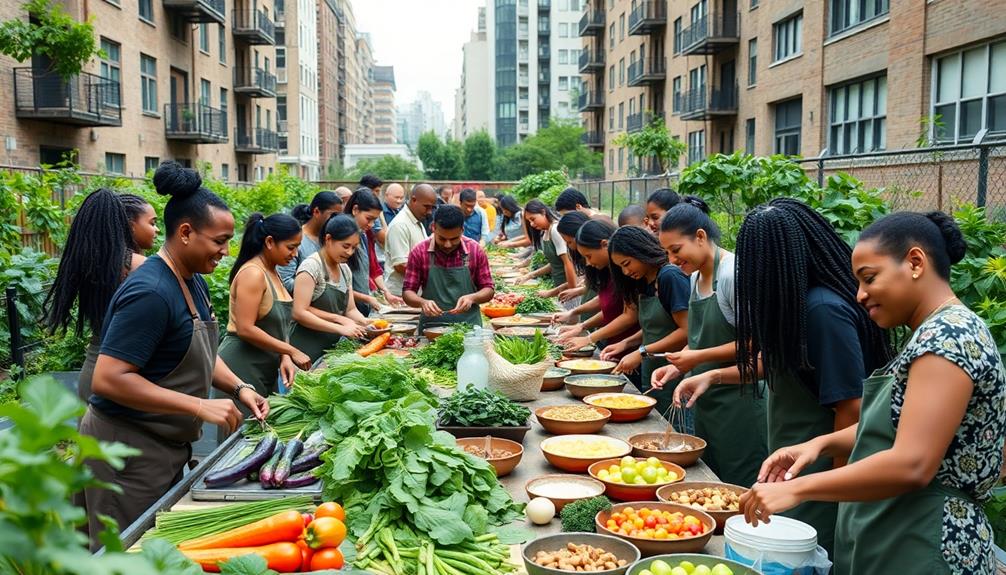
When you engage in cooking with local ingredients, you not only enhance your meals but also support your community's farmers.
Exploring traditional dishes like Muamba De Galinha can introduce you to rich flavors and cultural significance.
Educational cooking workshops empower you to explore new flavors and techniques, making culinary experiences more enjoyable and sustainable.
Local Ingredients Revolution
While the pandemic has reshaped many aspects of our lives, it has also ignited a powerful movement toward local ingredients, connecting communities through cooking. You've likely noticed the surge in urban agriculture initiatives, such as community-supported agriculture (CSA) programs, which have made locally sourced ingredients more accessible than ever.
This shift fosters direct connections between you and the producers, enhancing your appreciation for food sovereignty. As you experiment with local ingredients, you might find inspiration in traditional dishes like Agnolotti, showcasing regional culinary skills that celebrate local flavors.
Organizations like Fresh Roots engage students in hands-on cooking experiences, allowing you to prepare meals using fresh, locally grown produce. This not only boosts food literacy but also promotes culinary diversity as you explore traditional dishes from various cultures.
As urban farms cultivate diverse crops, you can discover new flavors and ingredients that reflect community heritage.
Moreover, GoodLeaf's vertical farms are transforming local restaurant menus, encouraging chefs to feature high-yield crops like baby kale and microgreens.
Educational Cooking Workshops
Connecting communities through cooking doesn't stop at sourcing local ingredients; it extends into hands-on educational cooking workshops that bring people together. These workshops often emphasize the use of locally grown produce, allowing you to engage directly with urban farms like Fresh Roots in Vancouver. Here, you can learn to prepare meals from seed to plate, gaining invaluable skills along the way.
Participants might even explore how to incorporate unique dishes like Dorayaki (Red Bean Pancake) into their cooking repertoire, showcasing the versatility of local ingredients.
By participating in these cooking workshops, you enhance your food literacy, understanding the nutritional benefits of fresh ingredients. This knowledge fosters a deeper connection with local food systems and encourages healthier eating habits within your community.
Many urban farms partner with local schools to host classes, teaching students to cook dishes with vegetables harvested from their own community gardens, enriching their understanding of the agricultural system.
Programs like GoodLeaf's seminars also inspire young farmers by merging cooking education with modern agricultural practices. These initiatives are often part of community-supported agriculture (CSA) programs, helping you maximize the use of your weekly CSA baskets.
This not only promotes creative cooking techniques but also reduces food waste, making cooking workshops a crucial component of community engagement in urban farming.
Education and Food Literacy

Urban farming initiatives offer you the chance to cultivate food knowledge while engaging with your community.
By exploring diverse culinary traditions, such as the rich flavors of Mushroom Masala, you can deepen your understanding of the ingredients and techniques involved in preparing meals.
Through hands-on learning experiences, you can connect with local food sources and understand sustainable practices.
These educational programs empower you to make informed choices about healthy eating and nutrition.
Cultivating Food Knowledge
Cultivating food knowledge is crucial for fostering a more sustainable and equitable food system. Urban farming initiatives like Fresh Roots in Vancouver are leading the charge by educating children about agriculture from seed to market. These programs emphasize food literacy, helping combat food insecurity while instilling a sense of responsibility toward food sourcing.
By introducing students to diverse cuisines, such as Ethiopian dishes like Yeselata and Yekolo, they learn to appreciate the variety of fresh produce available to them. Hands-on learning experiences engage students in understanding the entire food production process, deepening their connection to fresh produce.
Educational field trips at Lufa Farms teach students about natural pest control methods, highlighting the link between sustainable practices and effective food systems. GoodLeaf also plays a critical role by collaborating with schools to promote innovative growing methods through seminars.
This not only enhances students' knowledge of technology's role in modern agriculture but also empowers communities of color with crucial food knowledge. Through these initiatives, urban farming is transforming how individuals perceive and interact with their food sources.
Community Engagement Initiatives
Community engagement initiatives are transforming the way you and your neighbors interact with food and agriculture. By fostering food literacy, these programs empower underserved communities and promote a deeper understanding of where your food comes from. For instance, Fresh Roots in Vancouver has successfully educated kids about agriculture, providing around 70,000 meals to families in need during the pandemic. Urban farmers are at the forefront of these efforts, illustrating the significance of growing food sustainably.
Here's a glimpse at the impact of community engagement initiatives:
| Initiative | Focus Area |
|---|---|
| Fresh Roots | Education and food literacy |
| Lufa Farms | Natural pest control methods |
| GoodLeaf | Technology in farming |
| Community-Supported Ag. | Direct consumer-producer link |
| Urban Farming | Empowering youth and communities |
These initiatives emphasize community-supported agriculture (CSA) programs, enhancing access to fresh food and building direct relationships between you and local food producers. As you engage with these projects, you gain valuable insights into sustainable practices while supporting your local economy. This hands-on approach not only enriches your knowledge but also strengthens your community ties.
Hands-On Learning Experiences
Through hands-on learning experiences, you can gain a deeper appreciation for food and agriculture. Programs like Fresh Roots in Vancouver teach kids about cultivating food from seed to market, linking them directly to the meals they help prepare. This initiative has provided around 70,000 meals to families during the pandemic, addressing food insecurity while enhancing food literacy.
Engaging with local cuisine, such as tamales, allows participants to understand traditional food practices and the importance of local ingredients in their meals.
Field trips at Lufa Farms introduce students to natural pest control, emphasizing sustainable methods that promote healthy food choices. GoodLeaf's seminars engage young farmers with innovative growing techniques, inspiring creative thinking about food sourcing.
Meanwhile, Acta Non Verba in Oakland empowers youth through urban gardens, fostering community and belonging while they learn to cultivate fresh produce.
These hands-on experiences aren't just about growing food; they're about cultivating knowledge. As urban farming initiatives flourish, they play an essential role in teaching communities about healthy eating and sustainable practices.
You'll discover the importance of local food systems, and you'll likely feel more connected to the food you eat. Embracing these experiences can greatly improve your food literacy and, ultimately, your relationship with food.
Technology's Role in Urban Farming

Innovative technologies are transforming urban farming, making it more efficient and sustainable than ever before. For instance, Lufa Farms employs closed-loop hydroponic systems that recycle an impressive 90% of the water used, drastically cutting down on resource consumption.
GoodLeaf's vertical farms showcase how stacked trays can yield the equivalent of a 1.2-acre farm while using 95% less water, highlighting the efficiency of indoor agriculture. Additionally, urban farming can enhance food diversity by incorporating local ingredients, such as those used in traditional dishes like Kue Putu, which utilizes fresh coconut and palm sugar.
Robotics also plays an essential role in modern urban farming. Custom-made robots assist with plant care and production processes, boosting efficiency and lowering labor costs. This tech-driven approach not only enhances productivity but also guarantees fresh produce reaches consumers faster, positively impacting the food supply chain.
The global vertical farming industry is on the rise, projected to grow over 25% by 2027, reflecting a growing interest in sustainable, technology-driven solutions for food production in urban spaces.
Indoor farms, shielded from climate disruptions, utilize advanced air handling systems that recycle over 10,000 liters of water daily, reinforcing sustainability. With these innovations, urban farming is set to redefine how we grow and consume food, paving the way for a more resilient culinary future.
Impact on Food Security
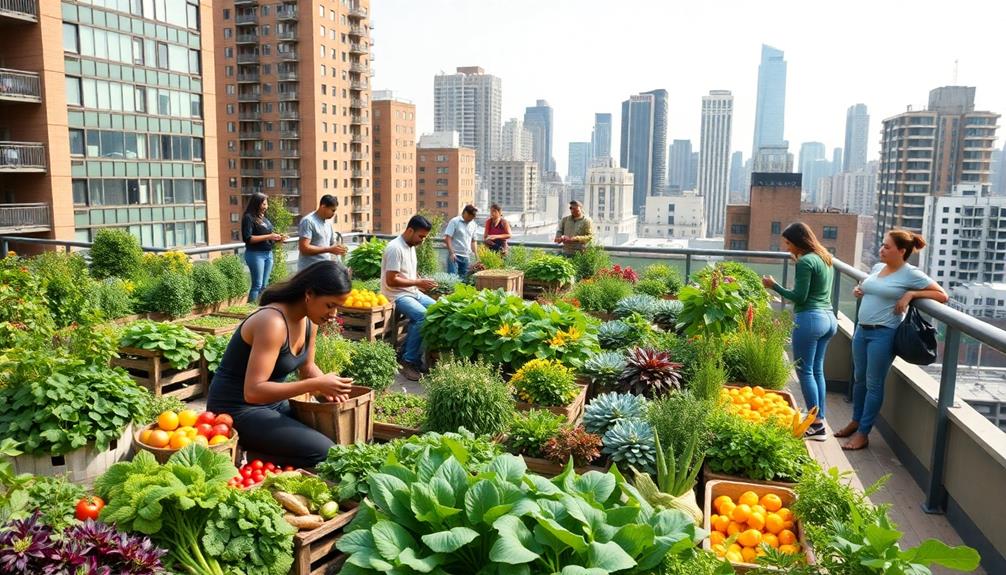
Food security is a pressing issue, and urban farming is stepping up to meet this challenge. As you might know, over 23.5 million people in the U.S. live in food deserts, where access to fresh produce is limited. Urban farming initiatives are essential for addressing these systemic disparities, bringing healthy food options directly to marginalized communities.
For instance, the incorporation of local food sources, such as those inspired by Thai street food, not only enhances food security but also empowers residents to take control of their food systems. By cultivating local food sources, urban farms not only enhance food security but also empower residents to take control of their food systems.
During the pandemic, community-supported agriculture (CSA) programs gained traction, offering direct access to locally grown food. This connection between consumers and producers strengthens communities while alleviating food insecurity.
Additionally, the global vertical farming market is expected to grow considerably, indicating a shift toward local food production that reduces reliance on traditional farming regions.
Urban farms can produce yields comparable to traditional farms, all while using up to 95% less water, especially in vertical setups. This sustainable approach is essential for tackling food security challenges in urban areas.
Ultimately, urban farming plays a critical role in ensuring everyone has access to fresh, nutritious food.
Frequently Asked Questions
How Is Urban Farming Influencing Food Production?
Urban farming's revolutionizing food production by increasing local access to fresh ingredients. You're seeing diverse crops flourish in cities, cutting transportation costs and promoting sustainability. This shift fosters community engagement and enhances food sovereignty in urban environments.
What Are the Negative Effects of Urban Farming?
Did you know over 30% of urban farms face soil contamination issues? Urban farming's negative effects include gentrification, limited water access, food mirages, and climate challenges, complicating food security and community dynamics in your neighborhood.
Will Urban Agriculture Change the Food System in Cities Around the World?
Yes, urban agriculture will transform food systems in cities worldwide. You'll see increased access to fresh produce, reduced food miles, and strengthened local economies, ultimately fostering healthier communities and more sustainable practices in food production.
What Are the Effects of Urbanization on Farming?
Urbanization's reshaped farming by increasing demand for local produce, pushing you towards innovative methods like vertical farming. It's also highlighted food deserts, prompting you to seek sustainable solutions that enhance food access and self-sufficiency.
Conclusion
In a world where culinary landscapes are evolving faster than you can say "farm-to-table," urban farming isn't just a trend—it's a revolution. By embracing local ingredients and fostering community connections, you're not just changing your plate; you're reshaping the very fabric of cuisine. Just like the Industrial Revolution transformed industries, urban farming is redefining how we think about food, sustainability, and togetherness. So, roll up your sleeves and join the movement—it's time to cultivate a tastier future!
-

 News4 months ago
News4 months agoYoung Tennis Prodigy Emerges: Merri Kelly Hannity
-

 Lifestyle4 months ago
Lifestyle4 months agoSocial Growth: How to Grow Your Home Decor Instagram Following!
-

 Vetted4 months ago
Vetted4 months ago15 Best Coastal Home Decor Items to Transform Your Space Into a Seaside Oasis
-

 Vetted4 months ago
Vetted4 months ago15 Best Home Decor Dupes That Look Expensive But Are Budget-Friendly
-

 Lifestyle4 months ago
Lifestyle4 months agoShow Your Love: How to Appreciate Someone's Home Decor in 5 Easy Steps!
-

 Vetted4 months ago
Vetted4 months ago15 Best Fireclay Farmhouse Sinks of 2024 – Style Meets Durability
-

 Lifestyle4 months ago
Lifestyle4 months agoUltimate Guide: How to Arrange Home Decor for a Stunning Look!
-

 Lifestyle4 months ago
Lifestyle4 months agoDIY Window Treatments: How to Install Home Decor Collection Blinds!































